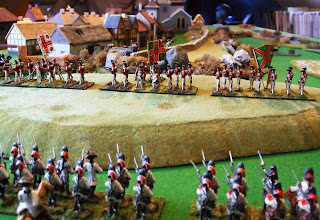We seem to be in a phase of looking at various rule sets at the moment and this week we tried out the "A Good Dusting" set for the Sudan. The scenario was based on the action at Kirkeban, with an Imperial force under the command of William Earle attempting to capture a village held by the Madhists. Even though the Imperial forces were outnumbered, Earle had detached a flanking force of three battalions plus all his cavalry to attack the enemy whilst his artillery supported by a few companies of HLI pounded their position and occupied their attention. It was a high risk strategy given the mobility of the Madhists and their considerable numbers. To the left centre of the Imperial position was a zariba with two machine guns, a detachment of Naval infantry and the hospital corps; supported by a battalion of Indian infantry.
The Madhists occupied three hills forming a ridge facing the Imperial position. Their best troops, the Beja, were in the centre, covering the village, whilst the Arab troops covered the flanks. The Madhists lacked any artillery and had few cavalry. Initially, their orders were to hold their position and wear down the infidels with rifle fire.
Earle's flanking march did not get off to a good start. His lead unit, the Light Horse strayed into rifle range and suffered heavy casualties from the Arab riflemen occupying the rocky hill to the right of the Madhist position. Quickly seeking cover in a palm grove the remaining cavalry dismounted and began to fire at the Arabs, but a combination of the long range, rocky cover and reduced numbers meant that the fire had little or no effect.
In the centre the main Imperial artillery battery, supported by two machine guns was having much more success. The Zanzibari riflemen suffering more casualties than they were inflicting and one unit fell back and had to rallied by the Madhist commander. Realising that he needed to relieve the pressure on his centre, the Madhist general ordered his right flank to attack the Imperial zariba. Although they suffered heavy casualties crossing open ground, Arab rifle occupied two rocky mounds close to the Imperial front line and began to shoot at the machine gun crews. Understandably, this 'put them off their game' and the main body of Arab swordsmen closed in on the Imperial defences.
Inside the zariba, every soldier able to stand was called forward to man the defences as a second body of swordsmen broke cover and headed for them. A breathing space was gained by the actions of the Indian Army battalion from Bombay. Their measured volleys drew one of the Madhist groups towards them and then as the range shortened, inflicted such heavy casualties that they never charged home.
The colonel in charge of the zariba had sent a young lieutenant off at the gallop, to inform Earle of the attack and request assistance. When he received the message, Earle had immediately ordered two battalions to countermarch to support the left flank and ordered the commander of the Egyptian battalion to advance slowly towards the enemy right firing volleys to pin them down. His cavalry were by now involved in a protracted melee with the Madhist cavalry and he hoped they had enough sense not to set off in a madcap pursuit.
Now came the crisis of the battle. Seeing the fire from the zariba weakening the Madhist commander ordered forward his Beja troops, sensing that they would reach the Imperial defences before Earle's men could intervene. Covered by the remaining Zanzibari riflemen the mass of fighters surged forward. The Imperial artillery fire was too weakened by losses to slow down the Mahdists and they crashed into the zariba defences. Red-coated infantrymen stood shoulder to shoulder with their comrades from the Royal Navy and desperately tried to force the forest of spears back. But the Madhist tide was relentless and step by step the Imperial troops were forced back into isolated clumps of fighting men.
By the time Earle's men reached the zariba it was all over. The Madhists had pulled back, leaving only the dead and dying.
We found the rules fairly easy to use, but a couple of aspects didn't seem to work well. Firstly, it seemed no more difficult to shoot deployed gun crews than close order infantry; nor did we find a modifier for shooting at skirmishers. This meant that the Arab riflemen's fire on the gun crews quickly reduced their effectiveness. Secondly, the morale (Pluck) test did not get more difficult as losses mounted or rounds of melee were lost. This enabled the Arab horse to remain in melee with the British cavalry for several moves and allowed the Madhist left flank to redeploy to cover the village.
These results may have been unfamiliarity with the rules or just an example of 'eccentric' dice rolling
US Army platoon in Vietnam
5 hours ago


















